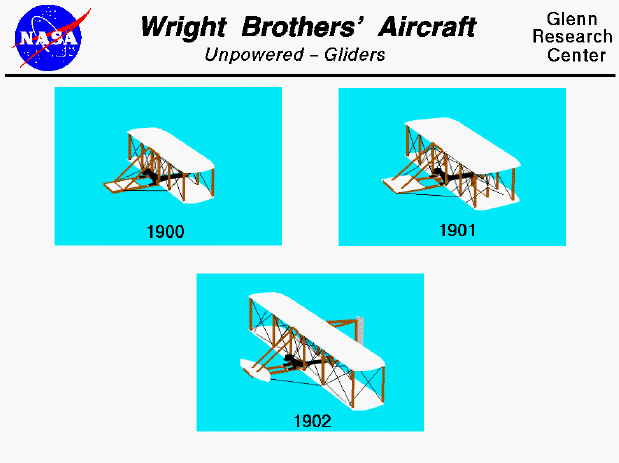
On this page, we show scaled computer drawings of the
unpowered aircraft which were built and flown by the Wright
brothers between 1900 and 1902.
The brothers used these aircraft to learn the basics of
aerodynamics
and flight
control.
They often flew these aircraft as
kites
to determine and verify aircraft performance.
The brothers also learned how to fly by using these unpowered aircraft
over 1000 times as piloted
gliders.
The brothers recognized that
control
of the flying aircraft was
the most crucial and hardest problem to solve. From the observation
of soaring birds, they believed that they could obtain roll
control by warping, or changing the shape, of
a portion of the wing.
In 1899 they tested some of their ideas on a large box kite flown in
their home town of Dayton, Ohio. By using multiple
control lines, the flyer could twist the wing tips of the kite and make
it move from side to side at will.
In 1900, the brothers decided to
further test their theories using an aircraft
designed to carry a man.
The aircraft was designed with two wings each having a 20 foot
wing span and a 5 foot chord. A forward stabilizer, called a
canard, was used for
pitch
control.
The aircraft weighed about 50 pounds without the pilot, and 200 pounds with
the pilot, .
Kitty Hawk, North Carolina, was chosen as the test site because of its constant
strong winds coming in from the sea and sand dunes for soft landings.
When the brothers arrived in North Carolina, they could only obtain 17 foot
long spars, so the actual aircraft was smaller than their original design.
For most of its
flights this aircraft was flown as a kite.
On the last day of the 1900 season, the
aircraft was flown as a
glider for about a dozen flights with Wilbur as the pilot. The aircraft
successfully demonstrated roll
control through wing warping.
In 1901,
the brothers returned to Kitty Hawk with a new aircraft
which they had built at their bicycle shop in Dayton, Ohio. Their new
aircraft had the same basic design as the 1900 aircraft, but was
larger to provide more
lift
to carry a pilot in lighter
winds. It had a 22 foot wing span, a seven foot chord, a variable
elevator canard for pitch control, and
weighed about a hundred pounds without the pilot. The aircraft was
flown frequently up to 300 feet in a single glide. But the aircraft
did not
perform
as well as the brothers had originally expected. The
aircraft only developed 1/3 of the lift which was predicted by the
lift equation
using Lilienthal's lift data. The brothers modified the
curvature
of the wing but this only slightly improved the flying
characteristics. During their test flights the brothers
first encountered wing
stalls
in which the lift would suddenly decrease and the aircraft would
settle back to earth.
They also encountered an effect known as adverse yaw. On some flights,
when the wings were warped to produce a roll
which should result in a
curving
flight path in the direction of the
lower wing, the
drag
increased on the upper wing and the aircraft
would twist in the opposite direction. The air speed decreased and
the plane settled back to the ground. At the end of 1901, the
brothers were frustrated and Wilbur remarked that it would be another
fifty years before humans would learn to fly.
During the winter of 1901, the brothers began to question the
aerodynamic data on which they were basing their designs. They built
their own wind tunnel, one of the first tunnels
built in the United States, and began to
test
their own models to accurately determine lift and drag of various wing designs.
They developed two ingenious balance systems, one for
lift and the other for
drag
to compare the performance of different models.
They tested over
fifty
different wing and airfoil sections in
different combinations to improve the performance of their gliders
They discovered the importance of wing planform shape on overall wing
performance. Shape effects accounted for some of the differences from
Lilienthal's results. They also calculated a more accurate value for the
Smeaton
pressure coefficient based on their flight tests.
This coefficient was the reference upon which all published aerodynamic was
based.
At the end of 1901, the brothers possessed the world's best aerodynamic data
for the design of glider wings.
In 1902,
they returned to Kitty Hawk with a new aircraft
based on their new data. This aircraft had nearly the same wing
area and weight of the 1901 aircraft, but the wings were long and thin
to reduce drag. The reduced drag had increased the
L/D ratio of the aircraft which allows for
a more shallow
glide angle and longer flights.
It had a 32 foot wing span, a five foot chord, the canard
elevator, a new movable rudder at the rear, and it weighed about a
hundred and fifteen pounds without the pilot. The rudder was
installed to overcome the adverse yaw problem. The movable rudder was
coordinated with the wing warping to keep the nose of the aircraft
pointed into the curved flight path. With this new aircraft, the
brothers completed over 300 flights with some flights
greater than 650 feet in length.
This machine was the
first aircraft that had active controls for all three axis; roll,
pitch and yaw.
At the end of 1902, the Wright brothers were the two most experienced
glider pilots in the world.
The stage was now set for
the development of powered
aircraft.
Navigation..



- Beginner's Guide Home Page
|
